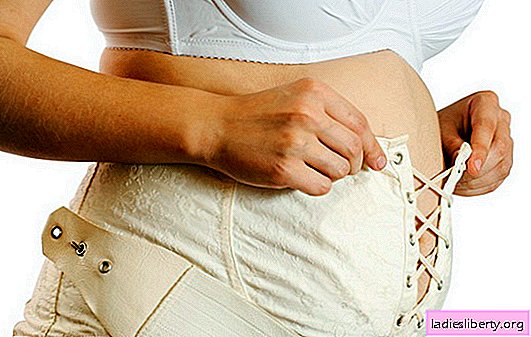
The period of pregnancy and the expectation of a baby is one of the magical moments in the life of every woman.
Of course, at the beginning no special changes can be seen, but already from the second half of the fourth month, the pregnant woman’s tummy increases rapidly, which contributes not only to the renewal of clothes, but in most cases, the wearing of a bandage.
A bandage is a special elastic device that helps not only pregnant women, but also babies in the womb.
When to Wear a Maternity Bandage
Only obstetrician-gynecologists can attribute a bandage. It’s not worth it yourself to resort to such a decision, because it can harm an unborn child in this way. From a medical point of view, the bandage necessary in such cases:
• for complaints of constant pain in the back and legs;
• in the presence of varicose veins (dilation of veins) or osteochondrosis;
• if there is more than one fetus;
• with low fetal placement in the second trimester;
• if there is a threat of miscarriage or childbirth prematurely;
• if there are scars on the uterus.
The prenatal bandage performs a number of functions that can facilitate pregnancy, namely:
• reduces pressure on a woman's back;
• prevents the appearance of stretch marks;
• correctly fixes the position of the fetus;
• prevents unplanned prolapse of the fetus;
• contributes to a more active lifestyle of the expectant mother.
Such an attribute of the wardrobe will become a truly integral part of the daily toilet. Those mothers who until the last days of pregnancy try to go to work and do all the household chores really need to wear a bandage. It will not only remove the load from the spine and lower back of the woman, but also help to avoid premature birth with very active behavior. Many women are afraid that near the end of the pregnancy period they may have a navel or pain when leaning forward. To save future mothers from unnecessary stress, obstetricians recommend purchasing this auxiliary attribute. Doctors believe that prolonged wearing of the bandage contributes to the residual fixation of the baby in the "head down" pose and will not allow the crumbs to turn over on the last days of pregnancy.
Remember, you can not always wear a bandage. It must be removed at night or when a woman goes into a horizontal position. Also, during the day it is important not to be in the bandage for more than three hours in a row, as this can harm the baby.
It is important to know, that in some cases the bandage is not only unnecessary, but also prohibited. If the baby is in the wrong position (legs down or across), if my mother found skin diseases or an allergy to the tissue. If a woman is absolutely healthy and can carry a child without problems throughout her pregnancy, there is no need to wear a bandage.
How to wear a bandage for pregnant women: the choice of bandage
To date, there are several options for bandages. They all differ in the form and manner of fixation, but they have one essence - to properly support the mother’s stomach.
1. The most common and inexpensive option is bandage panties. It has the form of underwear, but with a high elastic insert that fits tightly on the stomach. This insert should stretch as the volume of the abdomen increases. For fashionistas who want to look sexy even during pregnancy, manufacturers have released models such as thongs, shorts or lace. But many doctors express doubts about the effectiveness of this underwear.
Obvious minus panty brace is that it is really worn without any underwear, so you have to wash it very often, as a result - loss of appearance and elasticity. Moreover, such a bandage cannot be removed anywhere except at home.

2. Another type of bandage, which is not inferior in popularity to the previous one, is elastic support belt. It is fixed on the lower back and lower abdomen. Such a bandage is put on over the linen and fixed with special Velcro. This elastic belt does not soar and it is almost not noticeable under clothes. The negative side is that with a huge volume of the abdomen, such a bandage may not be very convenient and "crash" into the skin.

3. The next view is a combination of the two previous ones. Women call him "bandage hood". This is the same elastic belt, but with a high ribbon-insert that covers the entire stomach, like a real hood. This is a fairly versatile and convenient option. Such a bandage is worn on high underwear or simply lies on the skin and does not require frequent washing.

4. Universal or combined bandage. This view is an elastic tape with tabs in the form of Velcro. On the one hand, this tape is very wide, on the other - much narrower. Such an acquisition can be used both before and after childbirth. During pregnancy, the wide side is worn on the back, and the narrow side goes under the lower abdomen, like a belt. After childbirth, the sides change so that the abdominal muscles quickly come into shape.

5. There is another, less popular type of bandage. Honestly, he is considered a relic of the last century. It - a bandage on the ropes, or a bandage corset. Such an attribute is completely inconvenient to use and cannot be worn without assistance. The material from which this type of bandage is made is inelastic, so it is impossible to wear such a mowing throughout pregnancy, as the volumes of the abdomen increase. Fortunately, rope ties are not common among young mothers.

Important information! It is best to purchase bandages in maternity stores or pharmacies, where sellers will help you choose the right type and size of bandage. It should be made from natural fabrics and not cause allergies.
How to wear a bandage for pregnant women: how to wear
Any of these types of bandages must be worn and worn in accordance with the rules prescribed in the instructions for the belt. Namely:
• The bandage can be worn exclusively in a horizontal position by placing a special roller or pillow under the lower back and butt and lie down quietly before the procedure for several minutes. It is this position of the body that helps fix the uterus at the required height and evenly distribute the weight. Moreover, the fetus itself can freely take the necessary position in the lower abdomen and not press on the bladder.
• Gently and firmly fasten the bandage, but so as not to transmit the vessels and not to reduce the flow of blood to the stomach.
• If this is a belt, then skip it so under the lower abdomen to capture the pubis.
• Gently roll over to one side and stand up.
• Remove the bandage also when lying down.
Need to know, that doctors are strictly forbidden to wear a bandage in an upright position. This can cause a risk of severe pressure on the uterus and baby. From this putting on there is pain in the back and legs. Also, it is not allowed to wear a bandage for more than 7 hours a day or put it on a naked body.
How to wear a bandage for pregnant women: what can not be done in a bandage
As for the prohibitions for women who use pregnant bandages on an ongoing basis, there are a number of disagreements and contradictions that we will now try to deal with. The main frequently asked questions are:
• Is it possible to sit while using a bandage for pregnant women?
• Is it possible to go to bed without taking off the bandage for pregnant women?
As you know, a bandage is necessary in the first place to try to minimize the pressure and load on the spine and lower back of a pregnant woman while she is in an upright position. But, according to some experts, the constant wearing of a bandage is prohibited, since it disrupts the blood circulation of the child. In such cases, it is recommended to remove it every three or four hours to give the child a rest and a little movement. It is also forbidden to sharply and strongly lean forward, thereby creating additional pressure on the child.
It is necessary to remove the bandage both during daytime and during night sleep, since it will not perform its function in a lying position, due to the complete lack of load on the back, and can only harm the child. But on the question of whether it is possible to sit in a bandage, there are several conflicting opinions of experts. Some fully support and allow you to sit with the brace on, while others categorically insist on the contrary. Here the choice is entirely up to the mother. Be that as it may, do not forget that the main thing is a straight back and a sense of comfort. If while sitting, you are experiencing discomfort, you should immediately remove the bandage and wear it only while you are in an upright position.
If we consider postpartum bandages, then the restrictions on the order are more serious. Such a bandage has its own specifics and it is forbidden to wear it if:
• there are restrictions in the presence of caesarean sutures;
• there are diseases of the gastrointestinal tract;
• the appearance of edema in kidney disease;
• skin diseases and various allergic reactions.
And finally, it is worth noting that in any case, before you go to a specialty store or pharmacy for bandage, consult your doctor for advice. Only your doctor will be able to give a quality recommendation for the selection and purchase of a bandage. Based on the characteristics of your body and analyzing the course of your pregnancy, only he will be able to choose the type of bandage that is fully suitable for you.











